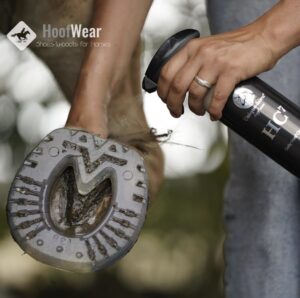Thrush is a common bacterial or fungal infection of the horse’s hoof tissue. It is often characterized by a black, foul-smelling discharge. Thrush typically affects the central frog or the grooves adjacent to the frog. However, in severe cases, thrush can also invade other parts of the hoof.
Even if your horse hasn’t ever had a problem with thrush, it is quite common and can occur on any hoof. It’s especially important to make yourself aware of this possibility as the seasons are changing and more wet weather is on its way. Thrush is more common in wet seasons and in milder climates.
What Causes Thrush?
- Poor hoof care (lack of regular cleaning and trimming)
- Unhygienic living conditions (overcrowded, muddy, and/or dirty stalls/pens)
- Lack of exercise and/or poor circulation
- Poor diet high in carbohydrates
Signs of Thrush
- Noticeable, pungent, foul smell coming from the hoof
- Thick, black substance in or around the frog
- Softened frog with unusually deep grooves
- Sore and tender heels
- Lameness

Treating Thrush
Prevention is key. Clean out your horse’s feet as often as you can. Keep your horse’s living environment as clean and dry as possible.
Even if you clean out your horse’s feet four times a day, though, there is still a chance thrush can start under the frog. If your horse does develop thrush, we recommend working with a hoof care practitioner and/or a veterinarian to come up with a treatment plan.
There are countless treatments and remedies for thrush on the market today. It may take a few tries to find the product and frequency that work best to treat your horse.
Gaseous Treatments

White Lightning, which is active Chlorine Dioxide (CI02), is often a popular choice. It is harmless to the tissue itself, but acts as a bacterial, fungicidical, sporidical, and virucidical agent. Unlike liquids, this gas can permeate the areas around the frog that are difficult or impossible to reach.
The treatment area needs to be completely sealed, so the gas cannot escape. One treatment method would be to put the affected hoof in an Easyboot Remedy, apply the white lightning, and then use saran wrap to seal the top of the boot. The treatment takes about 45 minutes and once the gas is released, the remaining liquid is harmless.
Liquid Treatments
Tomorrow, the Dry Cow Mastitis Treatment, comes in a syringe that works great for applying the gel deep between the heel bulbs.

Other liquid treatments such as Kopertox or Thrush Buster could be a good choice, as well. They can be a little easier to use, and they are great for reducing the chances of reinfection. Some will apply these every week or so throughout the winter and/or spring solely as a preventative measure.

A daily hoof cleanser that can be sprayed on, such as this one from Unique-Horn, could also be a great option for prevention.

Clay Treatments
A clay material, such as Artimud, can be used once the thrush has been treated to support the formation of healthy tissue and protect the frog area. This works well to fill the middle of an EasyShoe Versa Grip, for example. Its thick, putty consistency makes it easy to apply and helps it stay firmly in place so the protective agents can work for longer.
There are so many treatment options out there, it would be impossible to mention them all here. What is your favorite product to treat thrush?







